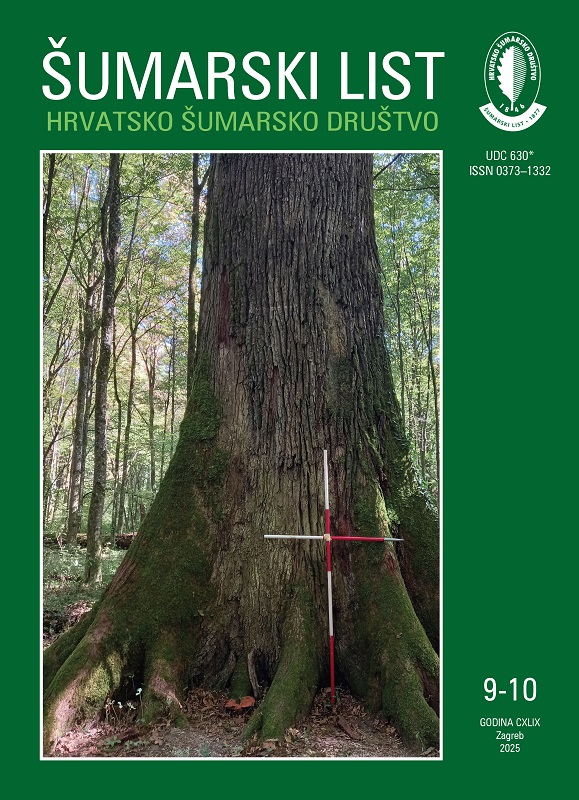| |
| RIJEČ UREDNIŠTVA |
| |
|
|
| Uredništvo HŠD | |
| No progress in forestry without science and without culture
pdf
HR
EN
|
409 |
| |
| IZVORNI ZNANSTVENI ČLANCI |
| |
|
|
| Ida Katičić Bogdan, Rudolf Stipetić, Antonio Vidaković, Marko Bačurin, Saša Bogdan, Zlatko Šatović, Igor Poljak | UDKps://doi.org/10.31298/sl.149.9-10.1 |
| Genetic diversity and genotyping of clones in clonal seed orchard of black pine (Pinus nigra J.F.Arnold)
pdf
HR
EN
|
411 |
| Jelena Kranjec Orlović, Fran Bono Cindrić, Darwin Damijanić, Damir Drvodelić, Mario Šango, Sanja Bogunović, Danko Diminić | UDKps://doi.org/10.31298/sl.149.9-10.2 |
| First report of Diaporthe eres associated with stem and branch canker on Quercus robur L. in Croatia
pdf
HR
EN
|
423 |
| Viktorija Brndevska Stipanović, Vlatko Andonovski, Saša Orlović | UDKps://doi.org/10.31298/sl.149.9-10.3 |
| Diversity of woody plants in urban parks of Skopje, North Macedonia
pdf
HR
EN
|
431 |
| Igor Poljak, Marijan Vuković, Ana Vuković, Matija Magdić, Antonio Vidaković, Ivana Zegnal, Doris Marjanović, Irena Šapić | UDKps://doi.org/10.31298/sl.149.9-10.4 |
| Leaf morphological variation in Ribes alpinum L. across elevation gradients in the north-western Dinaric Alps: evidence of phenotypic plasticity and habitat influence
pdf
HR
EN
|
443 |
Mountain ecosystems are shaped by steep environmental gradients that influence plant morphology and adaptation. Ribes alpinum L., a deciduous shrub with a wide European distribution, remains poorly studied in terms of its intraspecific variability. This study aimed to investigate leaf morphological variation across five natural populations from the Dinaric Alps, focusing on differences in leaf size and shape in relation to elevation and habitat conditions. Leaves were sampled from four populations and photographed in situ at a fifth site located within a strict nature reserve. Ten morphometric traits were measured – five related to leaf size (e.g., area, length, petiole length) and five describing leaf shape and lobe configuration. Statistical analyses revealed significant differences among populations in seven traits, with leaf size parameters showing the greatest divergence. Populations from contrasting elevations were consistently identified as morphologically distinct. The low-elevation population showed the greatest degree of within-population morphological diversity, likely reflecting the influence of heterogeneous terrain and fine-scale microhabitat variation. Multivariate analyses (PCA and clustering) confirmed population-level structuring, while Redundancy Analysis (RDA) showed that geographic coordinates had no significant influence on trait variation. Instead, elevation-related environmental gradients emerged as the dominant drivers of morphological differentiation. These findings suggest that leaf traits in Ribes alpinum are shaped primarily by local ecological pressures, reflecting phenotypic plasticity rather than broad spatial separation. The study highlights the adaptive flexibility of Ribes alpinum and underscores the ecological importance of the Dinaric Alps as a valuable setting for investigating plant responses to environmental heterogeneity.
|
| Neşe Gülci, John Sessions, Preston Green | UDKps://doi.org/10.31298/sl.149.9-10.5 |
| Assessment of tethered harvester productivity: a case study in western Oregon, USA
pdf
HR
EN
|
457 |
| |
| STRUČNI ČLANCI |
| |
|
|
| Zoran Šikić, Morana Bačić | UDKps://doi.org/10.31298/sl.149.9-10.6 |
| Spatial coverage of Natura 2000 forest target habitat types in Zadar County
pdf
HR
EN
|
467 |



